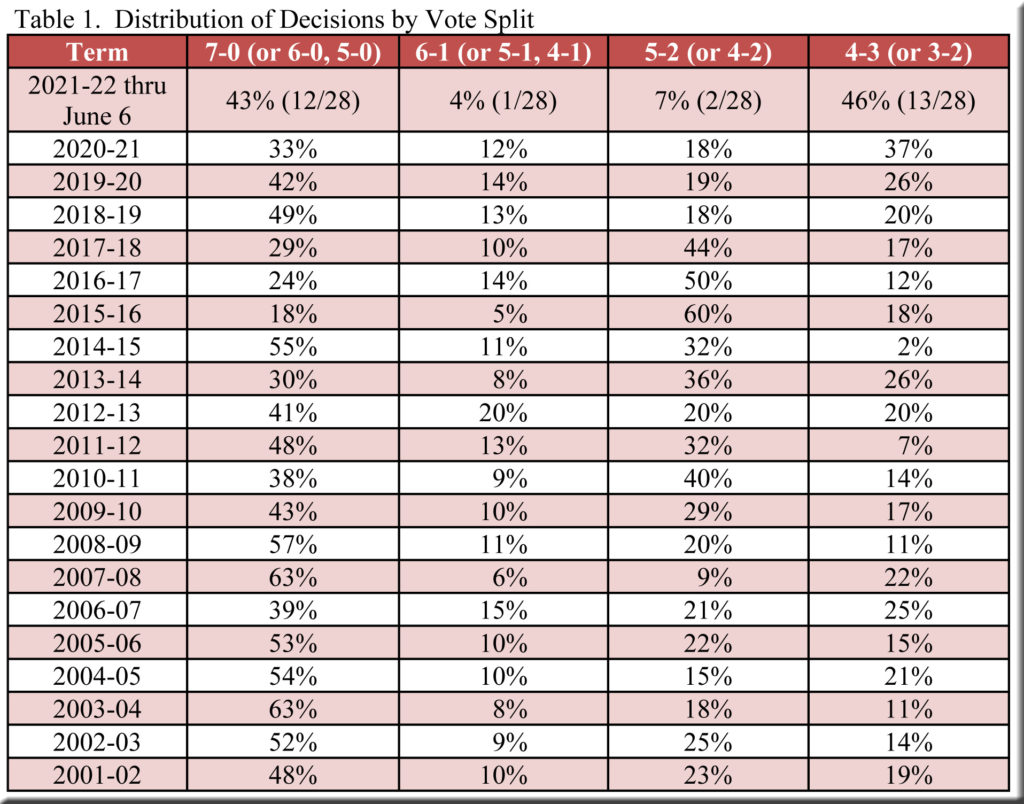One of the most noteworthy features of the decisions filed this term by the Wisconsin Supreme Court is the unprecedented percentage of 4-3 outcomes. Thirteen times already the justices have split 4-3, accounting for nearly half (46%) of the 28 cases decided as of June 6—by far the largest proportion of 4-3 decisions in the 73 years covered by SCOWstats. The previous high, 37%, came just the year before—itself a substantial increase over the entry for any of the other years in Table 1.
Meanwhile, 6-1 and 5-2 decisions have become extremely rare—jointly amounting to only 11% of all decisions to date. Table 1, which surveys the past two decades, reveals just how unusual these developments are—both the swelling percentage of 4-3 decisions and the evaporating total of cases decided by 6-1 or 5-2 margins.
Apart from the unparalleled share of 4-3 decisions, other points of interest catch the eye when turning to the frequency with which individual justices figured in 4-3 majorities. For instance, we gain confirmation of earlier findings[1] that the replacement of Justice Kelly by Justice Karofsky drastically amplified the importance of Justice Hagedorn’s vote in close cases. He joined the majority in only 36% of these cases in 2019-20,[2] but his vote became nearly essential in 2020-21, when he appeared 84% of the time in 4-3 majorities—and where he has remained every bit as vital in 2021-22 (Table 2).
Justice Kelly’s defeat by Justice Karofsky, combined with Justice Hagedorn’s independent or unpredictable voting pattern, also made liberals less scarce in 4-3 majorities in 2020-21. Specifically, after joining the majority in only about a quarter of 4-3 decisions filed in 2019-20,[3] Justices A.W. Bradley and Dallet voted the following term with 4-3 majorities in 42% and 47% of such cases, respectively. Even more striking, given that the court’s composition has not changed in 2021-22, liberals have continued to increase their presence in 4-3 majorities. To date, in fact, Table 2 shows them in this role slightly more often than the most conservative justices—a dramatic shift from the liberals’ meager representation only two terms before.
The justices are expected to file over twenty more decisions by term’s end this summer, and it will be interesting to see, once the dust has settled, if the preliminary impressions outlined above remain as vivid as they appear now.
[1] See “You’ve gotta win Hagedorn” and Original Actions and Judicial Activism: An Update for 2020-21.
[2] One of the 11 decisions in 2019-20 (State v. Mose B. Coffee) was decided by a 3-2 vote in which Justices A.W. Bradley and Hagedorn did not participate. This explains the difference between the Justice Hagedorn’s figures of 36% (four majority votes in the 11 cases decided by one-vote margins) and 40% (four majority votes in the 10 cases in which he participated, recorded in Table 2).
[3] As explained in the footnote above for Justice Hagedorn, State v. Mose B. Coffee was decided by a 3-2 vote in which Justices A.W. Bradley and Hagedorn did not participate. Thus, in 2019-20, Justice Bradley cast three majority votes in the 11 cases decided by one-vote margins (27%), which differs slightly from her figure in Table 2 of 30% (three majority votes in the 10 cases in which she participated).


[…] University history professor Alan Ball tracks the data for his website “SCOWstats,” which analyzes Wisconsin Supreme Court rulings by the numbers going back 73 […]